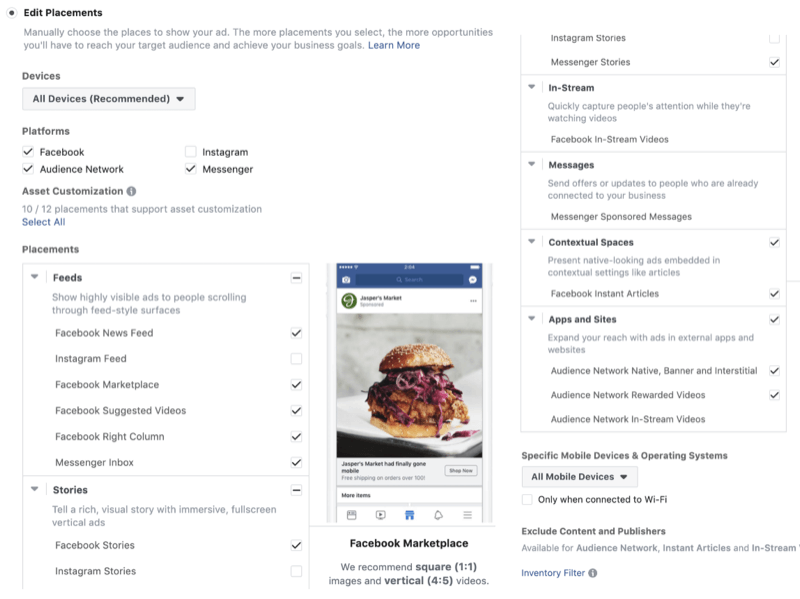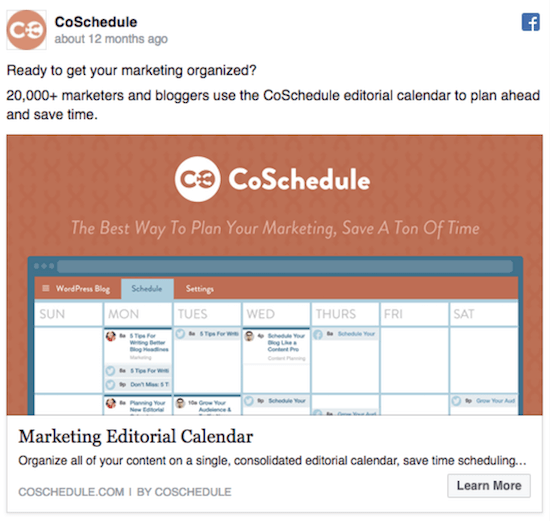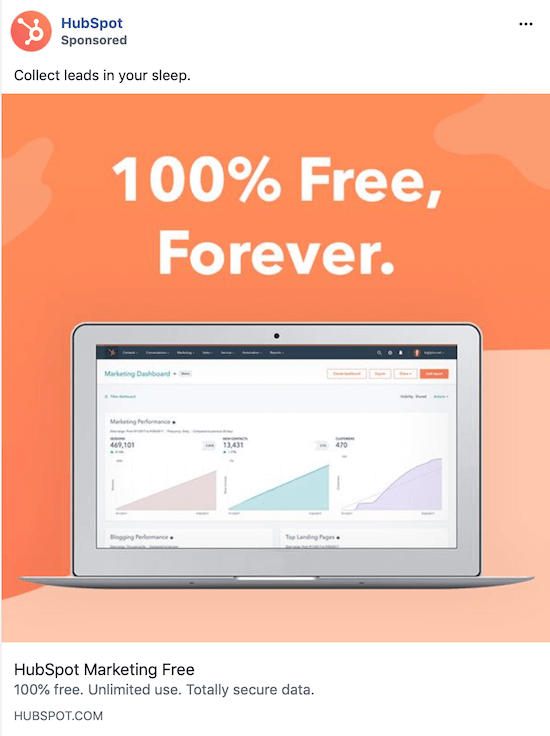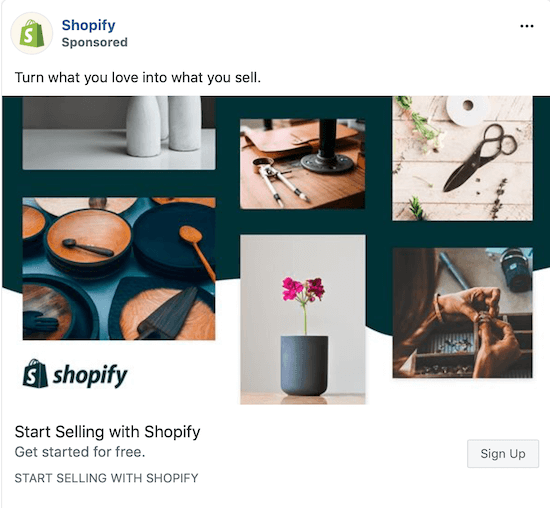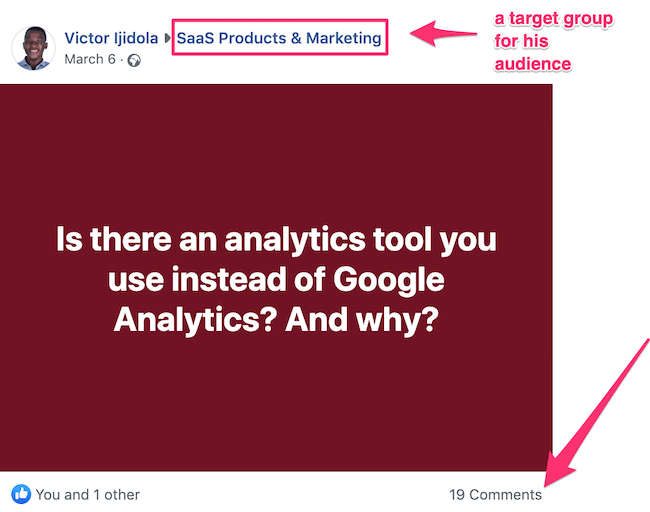
Want your Facebook ads to move people to action? Looking for a framework to help?
In this article, you’ll discover how to develop and compose Facebook ad copy that converts and sells your products.
#1: Research Customer Needs and Preferences in Facebook Groups
Marketers often talk about how hard it is to get accurate customer research data. That’s because customers are usually too busy to fill out survey forms or simply aren’t interested.
But Facebook groups can come to your rescue here. You can join groups where your target customers hang out and strategically ask them questions. It’s a win-win for you and them. They’re participating in the group to network with their peers and are actually interested in joining conversations there. So when you ask them thoughtful questions, they’ll likely be inclined to respond to them.
With a Facebook group, you can take a peek into your customer’s mind for free and then take what you’ve learned to write attention-grabbing sales copy for your Facebook ads. Keep in mind that you need to ask questions that will help you gather information that reveals the best messaging to use in your Facebook ads.
If you go to multiple Facebook groups to ask similar questions (without being spammy, of course), you’ll get even more responses.
In this example, Victor Ijidola (an SaaS copywriter) wanted to gather information to help write ad copy for a software business that provides the same function as Google Analytics. He found a Facebook group with software business owners and marketers, joined in their conversations, and then posed a strategic question.
It’s important to ask the right research questions so you can understand what target customers want from a product like yours. The goal is to get accurate data and use that information to map out a customer profile that genuinely represents your ideal customer.
If you’re selling a social media management tool, for instance, you want to understand your prospect’s criteria for choosing their favorite social media management software. So ask questions that lead you to that answer such as:
How to Get More Wins for Your Company or Clients—Expert Training! Don’t miss this event!
- What’s your favorite social media tool?
- Why did you choose that tool over others?
Use relevant Facebook groups for customer research, find what your target customers need, and write copy that describes the solution for those needs. In the end, all of these tactics will improve conversions.
#2: Turn Your Research Into Facebook Ad Copy
Once you’ve done your customer research and identified key customer pain points, prioritize those pain points. Rank them from most to least important.
When you compose your Facebook sales copy, start with the most challenging customer pain point you’ve found. This approach will help you write intros that draw customers’ attention. The punchier the intro, the better it will attract the attention you seek from prospects.
Data-Based Facebook Ads
This Facebook ad copy from CoSchedule captures attention right from the get-go:
Why does it work? The ad immediately seizes on one of the biggest problems marketers face: getting their marketing organized. As a marketer, you probably have at least 10 tabs open in your browser, a to-do list that stretches to the bottom of your screen, and KPIs that require countless tasks to hit.
CoSchedule tapped into all of these points and wrote an intro to their ad copy that would catch a busy marketer’s attention.
Aspiration-Based Facebook Ads
A lot of marketers have heard the “sell the benefits” copywriting advice so that’s all they do. But a better approach is to go beyond highlighting those benefits into exploring the “dream state” that customers are looking to achieve.
A social media agency might write the following in their Facebook sales copy to highlight one of the benefits brands would get from hiring them:
“Our social media services will grow your Facebook and Instagram audience in 3 months.”
It’s a good pitch but a better one would be:
“In 3 months, our social media services will bring ready-to-buy customers knocking on your door.”
Why is the second ad copy a better option? Because getting popular isn’t the dream for your customers; getting ready-to-buy customers is.
This HubSpot ad highlights a customer’s dream, not just solutions that every ad talks about:
HubSpot leads the ad with a line about a solution to help marketers collect leads in their sleep—and then in the ad headline below that, you find it’s a free tool. Prospects understand the tool automates lead collection, which is a benefit marketers won’t get without good software.
The key reason why highlighting dreams instead of solutions works is that it shows your customers you understand them deep down. And that’s often the first thing they need to know to pay attention to your sales copy.
Once you paint a picture that demonstrates you understand their problem and aspirations, you put your business in a position where prospects start to consider buying your product or service.
As an alternative to talking about a solution and the dream state you can help customers achieve, you could focus on their problem. You’ll have to think (or research) deep into that problem and describe it in your copy.
Here’s a punchy intro for a Facebook ad for Shopify:
This ad targets crafters—people who make things like jewelry, pottery, floral arrangements, and so on—and immediately identifies a challenge many of them face: getting no pay for their talent. They want to be paid for what they love to do.

Get Expert Social Media Marketing Training!
Want to keep ahead of your competitors? Need to master a social platform? Discover how to improve your social media marketing at Social Media Marketing World 2020, brought to you by your friends at Social Media Examiner. You’ll rub shoulders with the biggest names and brands in social media, soak up countless tips and new strategies, and enjoy extensive networking opportunities . Don’t miss the industry’s largest conference. Get in early for big discounts.
Sale ends Tuesday, October 1st 2019.
CLICK HERE TO LEARN MORE
It’s one-line copy but it’s effective. Your Facebook sales copy doesn’t always have to be lengthy. If you can communicate your product’s most important benefit to customers in one line, do it.
Problem-Based Facebook Ads
When writing Facebook ad copy that focuses on problems, the goal is to get prospects to nod their heads in agreement with something you said, giving you their attention at the same time.
Copywriting veteran Dan Kennedy puts it this way: “Set forth the problem in clear, straightforward terms. You need to say here only enough to elicit agreement.”
This ad copy from Asana digs into the problem their customers typically face: wasting time. The copy hits the nail on the head by spelling out the major challenge that people who need Asana face day in and day out.
On top of that, the ad creative digs deeper into the problem, pointing out that their product can “make work feel less like work”—a good reason for their target audience to click through the ad.
About Facebook Ad Sales Copy Length
Your sales copy can be long or short; it doesn’t matter. What counts is that it causes a shift to happen. It should transform the mind of the reader and entice them to hurriedly enter their credit card information on your checkout page and buy your product.
Frankly, and you may have heard this before, the way to determine whether to use long or short sales copy in your Facebook ads is to run tests. Test variations of ads with short, medium, and long copy.
The team at AdEspresso typically operates by a motto that encourages them to test everything they’re working on: “Never assume anything. Always test everything.”
And because it’s the mantra that fuels most of the actions they take, they invested $1,000 of real ad spend to find the scientific answer to which length of copy works best for their business. According to Paul Fairbrother, Facebook ads specialist at Hootsuite and AdEspresso, “The trend that we observed is that the mid to long ad text produced the lowest CPA and the maximum number of leads.”
Of course, these are the results for different types of copy length for AdEspresso. You need to find what works best for your business and product or service. Factors like your strategy, ad copy, timing, and location can make the results you get different from AdEspresso’s.
You need to run your own tests. Test different copy lengths and figure out what your own prospects respond to better.
#3: Align Facebook Ad Placements With Your Customer’s Decision-Making Process
You probably know this already, but if you opt to edit placements when setting up a Facebook campaign, you get to decide where to show your ads on most of the Facebook-owned platforms (Instagram, Messenger, Facebook, and Audience Network).
The ad placements you choose can diminish or enhance your sales copy.
If your goal is to generate leads or drive traffic, you might think you’ll get better results by placing your ads on virtually all of the platforms owned by Facebook, but that’s not how it works. You should choose placement options that help you achieve your goals; it’s not a one-size-fits-all scenario.
For a B2B, your goal for writing sales copy is to drive sales. This means you want people to see your ad at a time when they’re able to make a purchase decision, not when they’re scrolling through Facebook at the barbershop or doctor’s office.
Ideally, your prospects need to be at their computer when they see your B2B sales copy; it makes it easier for them to make a purchase decision.
The reason for this is that when B2B buyers want to make purchase decisions, they often need to open multiple browser tabs to find more information about your business, watch a demo, or email their superiors to get approval. That’s the typical B2B customer journey for many businesses, especially if your product or service is pricey.
You might be doing yourself a disservice promoting your B2B sales ads on mobile platforms. You’ve got a much better chance of driving high ROI with desktop ad placements.
Conclusion
Writing sales copy isn’t like writing blog posts, web copy, eBooks, or other fancy marketing material. It’s a different medium that requires good selling skills. When your ad copy is well-written—when you’ve mastered sales copywriting—you’ll convert and sell your products or services like a pro.
The key is to put the right words into your Facebook ad sales copy to make it sell effectively.
B2B marketers often get so caught up in the strategies, tools, and platforms they use to reach customers that they forget that they’re talking to real people, not just ‘prospects,’ ‘leads,’ or ‘subscribers.’ It’s easy to forget that simple, obvious fact.
Your customers have a profile picture you use to identify them but they’re more than that. They have bosses who could fire them if they’re not getting results or careers that could be destroyed if they make bad decisions.
Take the time to get to know your customers. Treat them as people. Understand that beyond buying the solution you’re selling, they’re ultimately looking for paradise. In your sales copy, communicate to them that you understand their problem and present the paradise they’re looking for in your product.
How to Improve Your Social Media Marketing Strategy—Expert Training! Don’t miss this event!
What do you think? What techniques do you use when writing ad copy? Share your thoughts in the comments below.
More articles on Facebook advertising:
read more at https://www.socialmediaexaminer.com by Justin Thomas
Digital marketing


